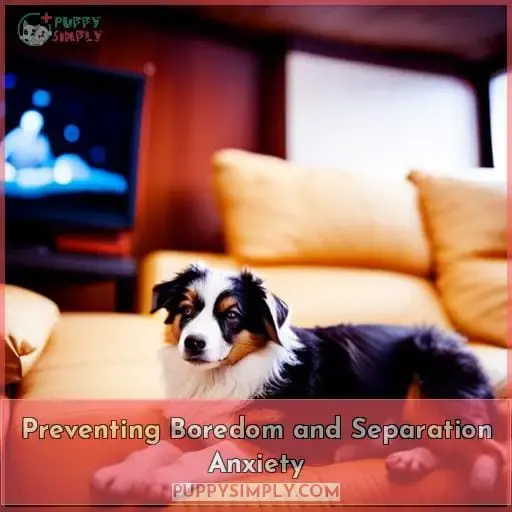This site is supported by our readers. We may earn a commission, at no cost to you, if you purchase through links.
 Imagine a dog, loyal and brimming with energy, happily trotting beside you through city streets or sprawling parks.
Imagine a dog, loyal and brimming with energy, happily trotting beside you through city streets or sprawling parks.
The Australian Shepherd, with its captivating eyes and boundless enthusiasm, can thrive in an apartment setting with the right care and attention.
While their boundless energy may seem overwhelming at first, understanding their unique needs and dedicating yourself to meeting them can create a harmonious bond that brings joy and companionship to your urban lifestyle.
Discover how to nurture a thriving relationship with your Australian Shepherd in an apartment environment, ensuring their physical and mental well-being while enriching your own life with their unwavering loyalty and boundless affection.
Table Of Contents
- Key Takeaways
- Australian Shepherd Temperament
- Exercise Needs of Australian Shepherds
- Training an Australian Shepherd in an Apartment
- Preventing Boredom and Separation Anxiety
- Providing Proper Care
- Frequently Asked Questions (FAQs)
- What size apartment is best for an Australian Shepherd?
- How loud is an Australian Shepherd’s barking, and will it disturb neighbors in an apartment building?
- Can I leave my Australian Shepherd alone in an apartment while I’m at work?
- Is there a risk of structural damage if my Australian Shepherd is bored or anxious in the apartment?
- What supplies, toys, or accessories make an apartment more accommodating for an Australian Shepherd?
- Conclusion
Key Takeaways
- They have high exercise needs, requiring about 60 minutes of vigorous activity per day.
- They are highly intelligent and need mental stimulation through interactive games, puzzles, and enrichment activities.
- Training them in an apartment requires optimizing the space for potty training and providing indoor physical and mental exercise.
- Establishing routines for walks, playtime, and meals gives them a sense of stability.
Australian Shepherd Temperament
As an experienced dog trainer, I can tell you that Australian Shepherds are highly energetic, very intelligent, and extremely loyal dogs.
Their energetic nature and strong work ethic mean they need plenty of physical and mental exercise to be happy, even in an apartment setting.
However, if properly stimulated, their intelligence and loyalty make Australian Shepherds rewarding companions.
Energetic
Because Australian Shepherds are so energetic, you’ll need to provide them with plenty of physical and mental stimulation if you’re raising them in an apartment.
Set up obstacle courses.
Play hide and seek.
Use puzzle toys.
Establishing a daily routine with designated times for walks, training, play, and rest can help Aussies in apartments regulate their energy.
Intelligent
You’ll frequently find that the highly intelligent Aussie is easy to train if provided with consistent mental stimulation.
Their intelligence means they thrive on cognitive challenges and learning new things through smart playtime and training.
Without sufficient mental agility activities, boredom and barking can become issues.
Providing regular mental adventures tailored to their smartness makes apartment living with an Aussie rewarding.
Loyal
Two. You’re rewarded with unwavering loyalty when you meet their needs through proper bonding techniques and training.
Their loyalty shines through when provided adequate physical and mental exercise.
Nurture strong loyalty dynamics within your family by establishing routines meeting their grooming, health, and toilet training requirements.
Satisfying their needs builds an incredible bond between energetic Aussies and apartment dwellers.
Exercise Needs of Australian Shepherds
As energetic herding dogs, Australian Shepherds require substantial daily exercise to stay healthy and happy.
Plan on providing your Aussie at least 60 minutes of vigorous activity per day, including:
- Walks
- Runs
- Fetching games
- Engaging in canine sports
Additionally, supply puzzles and interactive toys to provide mental stimulation between physical activities.
Daily Exercise Requirements
Your energetic Aussie needs at least an hour of vigorous exercise every day to meet their high activity requirements and prevent behavior issues.
Urban hikes, indoor agility, interactive play, and enrichment games like find it will sufficiently burn energy.
Parkour challenges build confidence and strength.
Potty train using positive reinforcement.
This herding dog thrives as a loyal, attentive family dog with proper daily exercise.
Mental Stimulation Requirements
Providing regular mental exercises will satisfy their intelligence while preventing destructive behaviors.
Introduce puzzle toys and interactive games to present cognitive challenges.
Rotate various enrichment activities daily to maintain their mental agility.
Seek additional guidance from veterinarians or certified trainers on specific mental stimulation requirements suitable for your Australian Shepherd’s needs.
Training an Australian Shepherd in an Apartment
Transition
Training an energetic herding breed like an Australian Shepherd in an apartment setting poses some unique challenges. However, with proper preparation and commitment, it can absolutely be done successfully.
When bringing your Aussie home to an apartment, be prepared to put in the effort to set them up for success.
- Provide ample indoor exercise through interactive games and food puzzles to stimulate their active minds and prevent destructive behaviors.
- Proactively address potential behavioral challenges like excessive barking and separation anxiety through positive reinforcement training methods.
- Optimize your apartment setup to accommodate potty training and meeting their mental stimulation needs with designated play areas and access to outdoor space for exercise.
With the right amount of effort invested into their care, training, and enrichment, Australian Shepherds can thrive as loving and loyal companions, even in apartments and smaller living spaces. The key is committing fully to providing for both their physical and mental needs.
Preventing Boredom and Separation Anxiety
You must provide plenty of interactive toys and activities to meet their high mental stimulation needs.
Establishing set routines for walks, playtime, and meals also helps reduce anxiety.
Consider crate training them as well to make them comfortable being alone for periods of time.
Providing Toys and Activities
Many interactive toys and daily activities will prevent your Aussie’s boredom and separation anxiety in the apartment:
Toys:
- Interactive Puzzles: Food dispensing toys that require manipulation to earn treats. Provide mental stimulation.
- Enrichment Balls: Balls that dispense treats during play. Engage natural chasing instinct.
- Tug Toys Galore: Rope and plush toys for tug of war games. Outlet for energy and bonding.
- Agility Challenges: Custom obstacle courses to leap over and through. Develop coordination and problem solving.
- Puzzle Feeders: Maze bowls that make earning meals a challenge. Slow down eating and work the brain.
Establishing Routines
You can establish consistent daily routines for your Aussie to help prevent boredom and separation anxiety when you’re away.
Structured habits like set times for walks, play, training, and meals create a sense of safety and belonging.
Building routines takes effort initially, but the regimen development and daily rituals pay off once your dog anticipates and thrives on the consistency.
Establishing routines provides the freedom from anxiety when you leave by creating habitual order.
Crate Training
By utilizing a crate properly, you’ll prevent your Aussie from becoming anxious or bored while you’re away.
Crate training benefits puppies by providing a safe, den-like space when unsupervised.
Use treats and toys to make the crate inviting.
Start slow, working up to longer periods inside while you supervise, praising calm behavior.
Controlling access enables good habits like resting when alone.
Challenges involve whining or soiled crates, but consistency overcomes.
Providing Proper Care
You’ll need to stay on top of their grooming, veterinary care, and feeding.
As their owner, it’s critical to:
- Brush them frequently.
- Take them to regular checkups.
- Feed them high-quality food in proper portions.
Caring for an energetic Aussie in an apartment takes diligence, but they’ll reward you with years of devoted companionship.
Grooming
One must regularly brush an Aussie’s thick double coat to remove dead hair and prevent matting.
- Brush thoroughly 2-3 times per week using a slicker brush to lift loose hair and a comb to detangle.
- Bathe every 2-3 months or as needed using a mild dog shampoo. Rinse thoroughly.
- Trim nails monthly to maintain good footing and dental health.
- Increase brushing during seasonal shedding periods to control loose hair.
Veterinary Care
Your Aussie needs regular vet check-ups to monitor overall health and address any medical issues early on.
Establishing a relationship with a veterinarian provides preventative care through health maintenance programs and wellness plans.
This includes vaccinations, heartworm prevention, dental cleanings, and screening tests.
Having an emergency plan prepares you to handle injuries or illnesses needing urgent veterinary care.
Providing good routine and emergency veterinary care ensures your Aussie stays happy and healthy.
Feeding
You’re feeding an Australian Shepherd a high-quality commercial dog food formulated specifically for active breeds.
Split their daily portion into two meals, as this breed is prone to bolting food.
Monitor their weight and adjust portions as needed to maintain ideal body condition.
- Feed two meals per day
- Provide appropriate portions
- Use dog food for active breeds
- Adjust based on ideal weight
Treat training allows for additional mental stimulation but limit treats to 10% of total calories to maintain nutritional balance.
Incorporate supplements if veterinarian recommended for joint health or skin issues.
Frequently Asked Questions (FAQs)
What size apartment is best for an Australian Shepherd?
An Australian Shepherd can thrive in a spacious studio or one-bedroom apartment if properly exercised.
However, a two-bedroom apartment allows for more dedicated space and separation between rest, play, and feeding areas to prevent behavioral issues.
The key is maintaining sufficient physical and mental stimulation regardless of apartment size.
How loud is an Australian Shepherd’s barking, and will it disturb neighbors in an apartment building?
Australian Shepherds are very vocal dogs.
Their loud, frequent barking can certainly disturb neighbors in an apartment building.
Proper training from a young age is essential to curb excessive vocalization.
But their natural herding instincts make them prone to barking alerts, so their volume must be carefully managed in apartments.
Can I leave my Australian Shepherd alone in an apartment while I’m at work?
You can leave an Aussie alone in an apartment while you work, but they need lots of exercise, training, and mental stimulation first.
Crate train them, provide interactive toys, walk them before and after work, and ease them into longer alone times to prevent behavior issues.
Socializing them well also helps.
Is there a risk of structural damage if my Australian Shepherd is bored or anxious in the apartment?
Yes, bored or anxious Aussies may chew, dig, and scratch, potentially damaging doors, walls, floors, and furniture.
Provide ample physical and mental exercise to satisfy their needs.
What supplies, toys, or accessories make an apartment more accommodating for an Australian Shepherd?
Provide puzzle toys, chew toys, and interactive feeders to stimulate their minds.
Rotating different toys keeps them engaged.
Take them on walks and play fetch daily to meet their exercise needs.
Massage mats and calming essential oils can help relax them in the apartment.
Conclusion
With Aussies’ energetic nature, apartment living may seem daunting.
But their loyalty shines through with proper care.
By providing daily exercise, mental stimulation, training, and preventing boredom, your energetic companion will thrive.
Lighting up your urban lifestyle with their captivating gaze.
Fulfill your Australian Shepherd’s needs, and their unwavering devotion will enrich your life at home.











